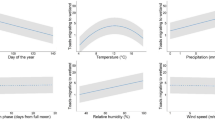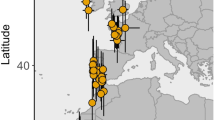Abstract
In species with explosive breeding strategies, large numbers of individuals may congregate at a defined location for a very short period of time. Effective synchronisation in arrival at breeding sites is crucial to ensure mating success. Amphibians with explosive breeding strategies often congregate at ponds for only a few days or weeks a year. Previous research has shown that frogs and toads may use a variety of exogenous cues to initiate breeding migrations which include temperature, rainfall and lunar cues. Although the effects of temperature and rainfall on amphibians are widely studied and understood, the impacts of lunar phase are poorly known and vary by species and location. In this study, we examined the effects of lunar phase on the numbers of common toads (Bufo bufo) and common frogs (Rana temporaria) migrating to breeding ponds at 43 sites across the UK over 4 years. Our findings show that peak migration of both common toads and common frogs coincides with the waxing phase of the moon, peaking around the full moon. Temperature and rainfall also had an effect on peak migrations with the highest numbers of common toads and common frogs occurring on warm and damp evenings close to a full moon. Our results have implications for amphibian conservation initiatives such as ‘Toads on Roads’ as they will help inform conservationists on the most effective timing to help toads and frogs across roads.



Similar content being viewed by others
References
Akçakaya HR (2000) Viability analyses with habitat-based metapopulation models. Pop Ecol 42:45–53
Andreone F, Giacoma C (1989) Breeding dynamics of Triturus carnifex at a pond in northwestern Italy (Amphibia, Urodela, Salamandridae). Holarc Ecol 12(3):219–223
Arnfield H, Grant R, Monk C, Uller T (2012) Factors influencing the timing of spring migration in common toads (Bufo bufo). J Zool 288:112–118
Baker BJ, Richardson JML (2006) The effect of artificial light on male breeding season behaviour in green frogs Rana clamitans melanota. Can J Zool 84:1528–1532
Batschelet E (1981) Circular statistics in biology, vol 111. Academic Press, London
Beebee TJC (1995) Amphibian breeding and climate change. Nature 374:219–220
Beebee TJC (1996) Ecology and conservation of amphibians. Chapman and Hall, London
Beebee TJC (2013) Effects of road mortality and mitigation measures on amphibian populations. Conserv Biol 2:657–668
Beebee TJC, Griffiths RA (2000) Amphibians and reptiles. HarperCollins New Naturalist, London
Bellis ED (1962) The influence of humidity on wood frog activity. Am Mid Nat 68:139–148
Bevier CR (1997) Breeding activity and chorus tenure of two Neotropical hylid frogs. Herpetologica 53:297–311
Blaustein AR, Belden LK, Olson DH, Green DM, Root TL, Kiesecker JM (2001) Amphibian breeding and climate change. Conserv Biol 15:1804–1809
Bryne PG, Roberts JD (2004) Intrasexual selection and group spawning in quacking frogs (Crinia georgiana). Behav Ecol 15:872–882
Carrier JA, Beebee TJC (2003) Recent, substantial and unexplained declines of the common toad Bufo bufo in lowland England. Biol Conserv 111:395–399
Carroll EA, Sparks TH, Collinson N, Beebee TJC (2009) Influence of temperature on the spatial distribution of first spawning dates of the common frog (Rana temporaria) in the UK. Glob Change Biol 15:467–473
Church G (1961) The effects of seasonal and lunar changes on the breeding pattern of the edible Javanese frog. Rana cancrivora:215–233
Cogălniceanu D, Székely P, Székely D, Roşioru D, Băncilă RI, Miaud C (2013) When males are larger than females in ecthotherms: reproductive investment in the eastern Spadefoot toad Pelobates syriacus. Copeia 2013(4):699–706
Degani G (2015) The habitats, burrowing behavior, physiology adaptation and life cycle of Spadefoot toads (Pelobates syriacus, Boettger, 1869) at the southern limit of its distribution in Israel. Open J Anim Sci 2015(5):249–257
Duellman WE, Trueb L (1994) Biology of amphibians. John Hopkins University Press, Baltimore, MD
Fahrig L, Pedlar JH, Pope SE, Taylor PD, Wegner JF (1995) Effect of road traffic on amphibian density. Biol Conserv 73:177–182
Fitzgerald GJ, Bider JR (1972) Influence of moon phase and weather factors on locomotory activity in Bufo americanus. Oikos 25:338–340
FitzGerald GJ, Bider JR (1974) Seasonal activity of the toad Bufo americanus in southern Quebec as revealed by a sand-transect technique. Can J Zool 52:1–5
Froglife (2019) Facts and figures, https://www.froglife.org/what-we-do/toads-on-roads/facts-figures/, Accessed 20 Oct 2020
Gittins SP, Parker AG, Slater FM (1980) Population characteristics of the common toad (Bufo bufo) visiting a breeding site in mid-Wales. J Anim Ecol 49:161–173
Glista DJ, DeVault TL, DeWoody JA (2008) Vertebrate road mortality predominantly impacts amphibians. Herp Conserv Biol 3:77–87
Gottsberger B, Gruber E (2004) Temporal partitioning of reproductive activity in a Neotropical anuran community. J Trop Ecol 20:271–280
Grant RA, Chadwick EA, Halliday T (2009) The lunar cycle: a cue for amphibian reproductive phenology? Anim Behav 78:349–357
Grant R, Halliday T, Chadwick E (2012) Amphibians’ response to the lunar synodic cycle—a review of current knowledge, recommendations, and implications for conservation. Behav Ecol 24:53–62. https://doi.org/10.1093/beheco/ars135
Green T, Das E, Green DM (2016) Springtime emergence of overwintering toads, Anaxyrus fowleri, in relation to environmental factors. Copeia 104:393–401
Greenberg CH, Tanner GW (2004) Breeding pond selection and movement patterns by eastern Spadefoot toads (Scaphiophus holbrookii) in relation to weather and ediaphic conditions. J Herp 38:569–577
Heinzmann U (1970) Untersuchungen zur bio-akustik und ökologie der geburtshelferkröte, Alytes o. obstetricans (Laur.). Oecologia 5:19–55
Hels T, Buchwald E (2001) The effect of road kills on amphibian populations. Biol Conserv 99:331–340
Henzi SP, Dyson ML, Piper SE, Passmore NE, Bishop P (1995) Chorus attendance by male and female painted reed frogs (Hyperolius marmoratus): environmental factors and selection pressures. Funct Ecol 9:485–491
Hiert C, Moura MO (2010) Abiotic correlates of temporal variation of Hypsiboas leptolineatus (Amphibia: Hylidae). Zoologica 27:703–708
Hussin AG (2007) Hypothesis testing of parameters for ordinary linear circular regression. J App Sci Res 3:185–188
Jammalamadaka SR, SenGupta A (2001) Topics in circular statistics, volume 5. New York World Scientific, New York
Johnson DH, Batie RD (2001) Surveys of calling amphibians in North Dakota. USGS Northern Prairie Wildlife Research Center 156. http://digitalcommons.unl.edu/usgsnpwrc/156. Accessed 27 Sept 2019
Kusano T, Inoue M (2008) Long-term trends toward earlier breeding of Japanese amphibians. J Herp 42:608–614
Kusano T, Miura T, Terui S, Maruyama K (2015) Factors affecting the breeding activity of the Japanese common toad, Bufo japonicus formosus (Amphibia: Bufonidae) with special reference to the lunar cycle. Current Herp 34:101–111
Landler L, Ruxton GD, Malkemper EP (2018) Circular data in biology: advice for effectively implementing statistical procedures. Behav Ecol Sociobiol 72:128
Loman J, Madsen T (2010) Sex ratio of breeding common toads (Bufo bufo): influence of survival and skipped breeding. Amphibia-Reptilia 31:509–524
Lovari S, Renzoni A, Fondi R (1976) The predatory habits of the barn owl (Tyto alba scopoli) in relation to the vegetation cover. Ital J Zool 43:173–191
Marsh DM, Rand AS, Ryan MJ (2000) Effects of inter-pond distance on the breeding ecology of túngara frogs. Oecologia 122:505–513
Mazerolle MJ (2004) Amphibian road mortality in response to nightly variations in traffic intensity. Herpetologica 60:45–53
Narayan EJ, Molinia FC, Christi KS, Morley CG, Cockrem JF (2010) Annual cycles of urinary reproductive steroid concentrations in wild and captive endangered Fijian ground frogs. Gen Comp Endocr 166:172–179
Olson DH (1989) Predation on breeding western toads (Bufo boreas). Copeia 1989:391–397
Padro CP d A, Uetanabaro M, Haddad CFB (2005) Breeding activity patterns, reproductive modes, and habitat use by anurans (Amphibia) in a seasonal environment in Pantanal, Brazil. Amphibia-Reptilia 26:211–221
Petrovan SP, Schmidt BR (2016) Volunteer conservation action data reveals large-scale and long-term negative population trends of a widespread amphibian, the common toad (Bufo bufo). PLoS One 11:e0161943. https://doi.org/10.1371/journal.pone.0161943
Reading CJ (1998) The effect of winter temperatures on the timing of breeding activity in the common toad Bufo bufo. Oecologia 117:469–475
Reading CJ (2007) The effect of winter temperatures on the timing of breeding activity in the common toad, Bufo bufo. Oecologia 117:469–475
Reading CJ, Clarke RT (1983) Male breeding behaviour and mate acquisition in the common toad, Bufo bufo. J Zool (London) 201:237–246
Rodrigues DJ, Uetanabaro M, Lopes FS (2004) Reproductive strategies of Physalaemus nattereri (Steindachner, 1863) and P. albonotatus (Steindachner, 1864) at Serra da Bodoquena, state of Mato Grosso do Sul, Brazil. Spanish Herp Rev 18:63–73
Ryan MJ, Tuttle MD, Taft LK (1981) The costs and benefits of frog chorusing behaviour. Behav Ecol Sociobiol 8:273–278
Scott AW, Pithart D, Adamson JK (2008) Long-term United Kingdom trends in the breeding phenology of the common frog, Rana temporaria. J Herp 42:89–96
SenGupta A, Ugwuowo FI (2006) Asymmetric circular-linear multivariate regression models with applications to environmental data. Env Ecol Stat 13:299–309
Sinsch U (1987) Orientation behaviour of toads (Bufo bufo) displaced from the breeding site. J Comp Physiol 161:715–727
Sinsch U (1988) Seasonal changes in the migratory behaviour of the toad Bufo bufo: direction and magnitude of movement. Oecologia 76:390–398
Tomašević N, Cvetković D, Aleksić I, Crnobrnja-Isailović J (2007) Effect of climatic conditions on post-hibernation body condition and reproductive traits of Bufo bufo females. Arch Biol Sci Belgrade 59:51–52
Trenham PC, Koenig WD, Mossman MJ, Stark SL, Jagger LA (2003) Regional dynamics of wetland-breeding frogs and toads: turnover and synchrony. Ecol Appl 13:1522–1532
Vaira M (2005) Annual variation of breeding patterns of the toad, Melanophryniscus rubriventris (Vellard, 1947). Amphibia-Reptilia 26:193–199
Verrell P, Halliday T (1985) Reproductive dynamics of a population of smooth newts, Triturus vulgaris, in southern England. Herpetologica 41:386–395
Walther G, Post E, Convey P, Menzel A, Parmesan C, Beebee TJC, Fromentin J, Hoegh-Guldberg O, Bairlein F (2002) Ecological responses to recent climate change. Nature 416:389–395
Wells KD (2007) The ecology and behavior of amphibians. University of Chicago Press, Chicago
Acknowledgements
The authors would like to dedicate this manuscript to the late Professor Tim Halliday (1945–2019), in gratitude for supervision and support of the PhDs of LJ and RG. LJ carried out this research in part due to funding from the John Ellerman Foundation and Esmée Fairbairn Foundation. We would like to thank the many toads on roads volunteers who have helped toads across the roads at all the study sites and sending data to Froglife. In particular, we would like to thank Chris Monk and John Heasor in providing valuable information on toad patrols. Thanks are also due to Ajoy Mukhopadhyay for his help with the numerical analysis of the data.
Author information
Authors and Affiliations
Corresponding author
Additional information
Publisher’s note
Springer Nature remains neutral with regard to jurisdictional claims in published maps and institutional affiliations.
Supplementary information
ESM 1
(DOCX 23 kb)
Rights and permissions
About this article
Cite this article
Jarvis, L.E., Grant, R.A. & SenGupta, A. Lunar phase as a cue for migrations to two species of explosive breeding amphibians—implications for conservation. Eur J Wildl Res 67, 11 (2021). https://doi.org/10.1007/s10344-020-01453-3
Received:
Revised:
Accepted:
Published:
DOI: https://doi.org/10.1007/s10344-020-01453-3




